Cabbage Key Management Area

At A Glance…
- 334 Acres
- Located near Tierra Verde
- Supports coastal hammocks and estuarine natural communities
Background
The Cabbage Key Management Area is in the Tierra Verde area of unincorporated Pinellas County. In addition to uplands found along the Pinellas Bayway, it contains several mangrove islands and 260 acres of Tampa Bay. Urbanization has caused major changes over the years to this part of the county. Historic aerial photographs show the islands of this region had very little development before being connected to the mainland and were primarily estuarine (brackish marsh) and coastal hammock natural communities.
Before 1965, the islands were connected by causeways and bridges to form what is now known as Tierra Verde. Later development in the region included residential housing and a golf course. The management area was acquired by the Pinellas County Board of County Commissioners in 1979. The area, which is closed to the public, is managed by Parks & Conservation Resources.
Characteristics
Water from the Cabbage Key Management Area drains to Tampa Bay on the east through surface flow and to the waters of Shell Key Preserve on the west from a drainage ditch. The ditch connects two brackish ponds that are the remnants of a marshy cove that existed before development. The surrounding area that drains into the Cabbage Key acreage primarily comprises highly fertilized St. Augustine lawns and ornamental vegetation, a tennis court and a baseball field.
The sandy marine soils are very well drained, which is a characteristic of coastal hammocks. The marshy communities are small mangrove islands that are frequently flooded and very poorly drained. The coastal hammock predominantly comprises mature live oaks, cabbage palms, wax myrtles and longleaf pines. The vegetation along the littoral zone, or shoreline, of the ditch is primarily red and black mangroves with a transition to cattails in the low-salinity ponds. The seagrasses to the east are expansive and healthy and primarily consist of turtle grass and shoal grass.
Management
In 2006, a restoration project was completed on about 20 acres of coastal hammock. This was a joint effort with Tampa Bay Watch and its volunteers, the Tampa Bay Estuary Program and Pinellas County. Contractors cut, treated and mulched non-native vegetation in the hammock and along the shorelines of the wetlands. Brazilian pepper and lead tree were the predominant non-native species treated.
Volunteers helped replant the site with native vegetation, including muhly grass, sand cordgrass, sabal palm and sea grape. Many native species were discovered once the exotic vegetation was removed. For example, slender sandbur, never before recorded in Pinellas County, was found along with the rare prickly pear and giant air plant. Additional restoration efforts aim to remove more non-native vegetation and prevent the re-invasion of previously treated areas.
Value
While The Cabbage Key Management Area has special significance to local residents and provides economic and environmental benefits to its neighbors, this natural space provides valuable services to all residents and visitors to the region. By protecting native biodiversity, it supports countless organisms ranging from microbes to mammals. For example, diverse migratory fowl use the two low-salinity ponds every year.
The coastal hammock communities represented in this area have all but vanished elsewhere in the region because of urbanization. This management area also makes important contributions to the coastal environment by protecting seagrass beds that provide essential habitat to many marine organisms.
For additional information:
Parks & Conservation Resources
12520 Ulmerton Road
Largo, FL 33774
Phone: (727) 582-2100
Fax: (727) 582-2550